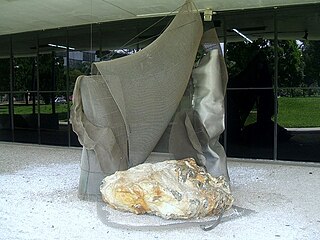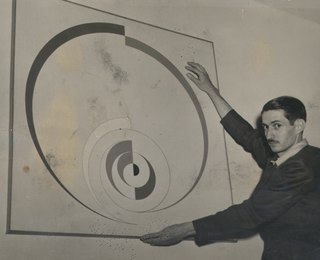Early work
During the 1970s, Andrade was a part of a circle of young artists which included Fernando Cocchiarale, Anna Bella Geiger, Ivens Machado and Leticia Parente that began to respond to the severe period of censorship under the military dictatorship in Brazil through intense productions of individual expression through a simple, direct body language. Overt and accusatory actions were revealed without technical or formal intentions to the tight frame of the camera. [4]
Many of Andrade's early videos feature her performing awkward and painful actions to invoke thought about torture practices employed by the Brazilian government during the dictatorship. For example, Primeira Seria, a 'first series' of videos shot by Andrade in Rio and São Paulo featured television images of Andrade winding a nylon thread around her face until it is disfigured, attacking her body hair with a scissors, driving nails between her fingers, trying to move about with her limbs and head enclosed in bird cages. This series is said to be a critique of television as a tool of conditioning, an echo of the political regime's authority. [4]
Andrade's critique of media and television was also featured in her earliest films. In Untitled (1975), Andrade sat at a table eating a traditional Brazilian meal of black beans, smoked pork, ad sausages with a television set broadcasting an American sitcom and commercials in the background. The seemingly every day scenario turns unexpectedly as discontent awakens inside the artist. The previously harmless television is featured as a source of misery and oppression as the artist begins smearing the beans on her head; shoving them into her mouth with her hand; wiping them on her eyes, ears, and inside her clothes; and ultimately, throwing them at the lens until the scene is obliterated. In Untitled (1977), Andrade appears in front of four televisions and turning them on one by one, then speaks to the audience directly by repeating "turn off the TV" for more than ten minutes to highlight the passivity of the viewers. [5]

Lygia Pimentel Lins, better known as Lygia Clark, was a Brazilian artist best known for her painting and installation work. She was often associated with the Brazilian Constructivist movements of the mid-20th century and the Tropicalia movement. Along with Brazilian artists Amilcar de Castro, Franz Weissmann, Lygia Pape and poet Ferreira Gullar, Clark co-founded the Neo-Concrete movement. From 1960 on, Clark discovered ways for viewers to interact with her art works. Clark's work dealt with the relationship between inside and outside, and, ultimately, between self and world.

Sérgio de Camargo was a sculptor and relief maker, born in Rio de Janeiro, Brazil. Sergio De Camargo studied at the Academia Altamira in Buenos Aires under Emilio Pettoruti and Lucio Fontana. Camargo also studied philosophy at the Sorbonne in Paris. On a protracted trip through Europe in 1948, Camargo met Brâncuși, Arp, Henri Laurens and Georges Vantongerloo.Sérgio de Camargo showed work at numerous international exhibitions, including the 1965 São Paulo Biennale, the 1966 Venice Biennale, and the 1968 documenta in Kassel. Sérgio de Camargo died in Rio de Janeiro in 1990. The Tate Gallery in London has one of de Camargo's work in their permanent collection.
Brígida Baltar was a Brazilian visual artist. Her work spanned across a wide range of mediums, including video, performance, installation, drawing, and sculpture. She was interested in capturing the ephemeral in her artwork.

The creation of art in the geographic area now known as Brazil begins with the earliest records of its human habitation. The original inhabitants of the land, pre-Columbian Indigenous or Natives peoples, produced various forms of art; specific cultures like the Marajoara left sophisticated painted pottery. This area was colonized by Portugal in the 16th century and given the modern name of Brazil. Brazilian art is most commonly used as an umbrella term for art created in this region post Portuguese colonization.

Hélio Oiticica was a Brazilian visual artist, sculptor, painter, performance artist, and theorist best known for his participation in the Neo-Concrete Movement, for his innovative use of color, and for what he later termed "environmental art," which included Parangolés and Penetrables, like the famous Tropicália. Oiticica was also a filmmaker and writer.
Cybèle Varela is a Brazilian mixed-media artist. She is a painter, video artist, and photographer.

Lygia Pape was a Brazilian visual artist, sculptor, engraver, and filmmaker, who was a key figure in the Concrete movement and a later co-founder of the Neo-Concrete Movement in Brazil during the 1950s and 1960s. Along with Hélio Oiticica and Lygia Clark, she was an important artist in the expansion of contemporary art in Brazil and pushed geometric art to include aspects of interaction and to engage with ethical and political themes.

Christina Oiticica is a Brazilian artist. She has been married to Paulo Coelho since 1980.

Anna Bella Geiger is a Brazilian multi-disciplinary artist of Jewish-Polish ancestry, and professor at the Escola de Artes Visuais do Parque Lage. She lives in Rio de Janeiro, and her work, characterized by the use of different media, is held by galleries and private collections in the US, China, Brazil and Europe.
Raul Mourão' is an artist. His artwork includes the production of drawings, sculptures, videos, texts, installations and performances.
The Neo-Concrete Movement (1959–1961) was a Brazilian art movement, a group that splintered off from the larger Concrete Art movement prevalent in Latin America and in other parts of the world. The Neo-Concretes emerged from Rio de Janeiro’s Grupo Frente. They rejected the pure rationalist approach of concrete art and embraced more phenomenological art. The Neo-Concrete movement called for greater sensuality, color, and poetic feeling in concrete art, distinguishing itself from the more rigid approach of the original Concrete Art movement. Ferreira Gullar inspired Neo-Concrete philosophy through his essay “Theory of the Non-Object” (1959) and wrote the “Neo-Concrete Manifesto” (1959) which outlines what Neo-Concrete art should be. Lygia Clark, Hélio Oiticica, and Lygia Pape were among the primary leaders of this movement.
Grupo Frente was a group of Brazilian artists originated in Rio de Janeiro which existed from 1952-64. The group was led by Ivan Serpa, and was formed by artists such as Helio Oiticica, Aluisio Carvão, Lygia Clark, and Lygia Pape. Many of them studied under Ivan Serpa. Each of them came from different styles of art, but they all embraced the ideals of Concrete art, or what is now called geometric abstraction.
Anna Maria Maiolino is a Brazilian contemporary artist.

Iole Antunes de Freitas is a Brazilian sculptor, engraver, and installation artist who works in the field of contemporary art. Freitas began her career in the 1970s, participating in a group of artists in Milan, Italy linked to Body art. She used photography. In the 1980s, she returned to Brazil, but abandoned the human body as mediator of her work, adopting the "sculpture body". The artist uses materials such as wire, canvas, steel, copper, stone, and water to create her works.

Antonio José de Barros Carvalho e Mello Mourão, known professionally as Tunga, was a Brazilian sculptor and performance artist. Tunga was born in Palmares, Pernambuco, Brazil.
Maria Lynch Rio de Janeiro born 1981 is a Brazilian artist

Ivan Ferreira Serpa was a Brazilian painter, draftsman, printmaker, designer, and educator active in the concrete art movement. Much of his work was in geometric abstractionism. He founded Grupo Frente, which included fellow artists Lygia Clark, Helio Oiticica, and Franz Weissmann, among others, and was known for mentoring many artists in Brazil.
Vera Chaves Barcellos is a Brazilian artist and educator. She was featured in the Radical Women show at the Brooklyn Museum in 2018.

Wanda Pimentel was a Brazilian painter, based in Rio de Janeiro, Brazil. Her work is distinguished by "a precise, hard-edge quality encompassing geometric lines and smooth surfaces in pieces that often defy categorization as abstract or figurative. “My studio is in my bedroom,” Pimentel said in an interview. “Everything has to be very neat. .. I work alone. I think my issues are the issues of our time: the lack of perspective for people, their alienation. The saddest thing is for people to be dominated by things.”

Marcela Cantuária is a Brazilian visual artist working primarily with paintings. Cantuária's work revolves around contemporary historical paintings produced in small and large formats. Recurring themes in her work are social movements, political history, feminisms, and environmental causes in Latin America.











